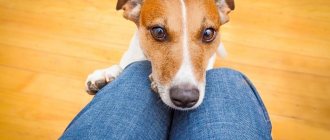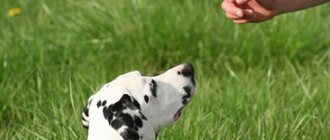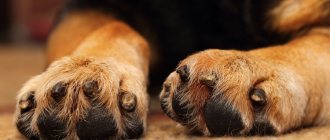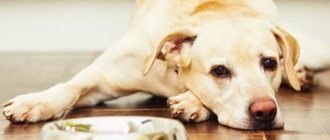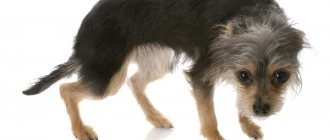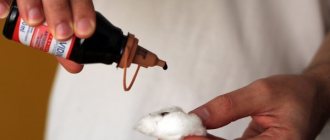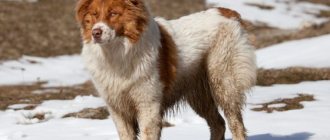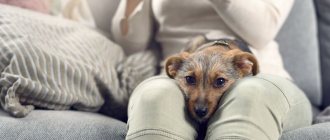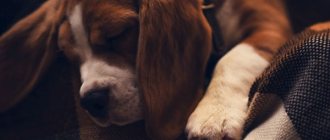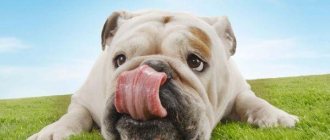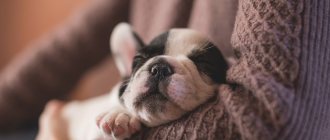Owners sometimes notice rapid breathing in their dogs. And there can be many reasons for this: from a normal physiological phenomenon to the manifestation of a disease or, even worse, the occurrence of a condition that threatens the pet’s life. Therefore, you should be aware of this pathology so as not to make mistakes and take timely measures.
Why does it happen that a dog breathes quickly?
It has been established that in a calm state, our four-legged friends usually take 10-30 breaths per minute. But this value is conditional and depends on the size of the dog and its age. The breathing rhythm changes after significant physical activity, during long running, etc. This is especially typical for the hot season, when the frequency of breaths per minute can reach 160. The pet’s breathing will become faster due to overexcitement. The breathing rate is different and the animals are restless and have an unstable nervous system.
These are all normal physiological phenomena. But when rapid breathing occurs with minimal activity or even at rest, one should already think about pathology. In this case, it is useful to observe the animal. In a calm environment, the dog does not open its mouth when breathing and does not make any noise (of course, in the absence of a special structure of the muzzle, for example, like pugs, then the pets not only sniffle, but also snore). There can be many reasons why a dog is breathing rapidly:
- cardiac pathologies;
- pulmonary diseases;
- unhealthy pulse;
- neoplasms in the respiratory tract or lungs;
- pneumonia due to an infectious lesion of the body;
- obstruction of the respiratory tract;
- injury accompanied by bleeding into the chest or accumulation of fluid in it, etc.
When your pet begins to breathe faster for no good reason, it means that he should be taken to the veterinary clinic. After all, this already predominantly indicates the presence of a pathological condition, which must be identified in order to provide qualified assistance.
Diagnosis of rapid breathing in a dog
First you need to exclude external factors: stress, heat, anxiety. After this, take the animal to the clinic. It is important to create peace and comfort for the dog. But don't overdo it! Do not try to force water on an animal, it can be dangerous. You wish him well, but a sick and frightened dog can behave unexpectedly.
At the veterinarian
If a dog has difficulty breathing, then the main task is to supply oxygen.
This is done using an oxygen mask or placing the animal in an oxygen chamber.
At the same time, the veterinarian will begin an examination - listen to the heart, measure the pulse. To identify the causes, the veterinarian conducts a series of studies.
To identify the cause, use:
- X-ray (exclusion of a foreign body in the respiratory tract and tumor)
- Electrocardiogram
- Ultrasound of the heart
- A general and biochemical blood test is required
Symptoms of rapid breathing and heartbeat
With rapid breathing caused by malaise, changes in the animal's behavior are immediately noticeable. It can be:
- restless behavior, trembling;
- cough, shortness of breath, hoarseness;
- blue gums;
- reluctance to eat;
- vomiting, diarrhea.
Moreover, if the dog has rapid breathing and heartbeat, as well as trembling, it is almost impossible not to see all this. When a pet exhibits disorientation, it is most likely to suffer from heatstroke. He should be placed in a cool place, given a drink, and a wet towel applied to his head.
A bluish tint to the tongue and fainting can occur with heart problems. In this case, the animal should be well covered, warm heating pads should be applied to its paws, a veterinarian should be called to the house, and before his arrival, Cordiamine should be administered intramuscularly. But the presence of a whole set of the above symptoms should be a particular cause for concern. In this case, a visit to an experienced veterinarian is mandatory, because this is exactly the case when, as they say, delay is like death.
Emergency help for rapid breathing
But it happens that the pet’s condition worsens, and it is not possible to transport it immediately to a veterinary clinic. Then the owner himself should provide first aid. First of all, the animal should be given complete rest. Place it in a separate room or in a quiet, cool corner. Try to ventilate the room to ensure a flow of fresh air.
But at the same time, there is no need to force him to settle, nor do you need to force him to drink a lot. After all, you can only make the situation worse. Having created such conditions, you need to take care to call a veterinarian at home. And before he arrives, you should under no circumstances give your pet any medications. After all, this can only complicate the further process of therapy.
But it’s best to try to deliver the dog to the clinic yourself, in order not to waste precious time. Here, different treatment methods will be used to make an accurate diagnosis, and there is everything to take urgent measures if something happens. So, a special mask is used to saturate the dog’s body with oxygen. And if such a measure does not have the desired effect, surgical intervention may be performed.
Sick dog
171
If your dog exhibits the following symptoms, you can assume it has rabies. In this case, you should immediately contact a veterinarian.
The following symptoms are meant: coldness, increased excitability, timidity, willfulness, depression, loss of appetite and at the same time the desire to chew inedible things (for example, furniture, shoes, earth, stones, blankets, etc.).
If the dog reacts even to weak light stimuli, moves staggering, if its aggressiveness increases, a desire to run away appears, and barking turns into howling, if paralysis of the hind limbs and lower jaw occurs in the last stage of the disease - all these are signs of rabies. Rabies is an incurable viral disease. It threatens many species of wild animals, domestic animals and humans. Mad animals must be destroyed. If a person has even the slightest suspicion of being infected with rabies, he should immediately consult a doctor. Preventive measures: in areas where quarantine has been introduced due to cases of rabies, it is necessary to strictly follow all instructions, in particular, not to let the dog go for a walk alone. During the quarantine period, the dog's walks should, if possible, be limited to the area immediately adjacent to the house; the dog should always be taken out only on a leash and encounters with other dogs should be avoided.
172
If there is severe itching, when the dog scratches continuously, a suspicion of scabies arises.
The disease is caused by mites (150) and leads to hair loss and ulcers. Veterinarian intervention is required. All items and the dog’s bed must be thoroughly disinfected.
173
Inflammation of the conjunctiva or cataracts manifest as purulent or watery discharge from the eyes.
The disease is very often caused by drafts (151).
In most cases, it can be easily and quickly cured by washing the eyes with a 2 percent boric acid solution or filtered chamomile extract. It is recommended to take the dog's temperature (168), as discharge may be a sign of distemper. In doubtful cases, call a veterinarian.
174
If a dog is shaking its head so hard that its ears are popping, its ears are obviously sick.
Inflammation of the ear canal occurs more often in dogs with long, thickly furred ears than in dogs with short ears. Animals that have their ears cleaned regularly (149) rarely develop this disease. If your dog does become ill, we recommend that you consult a veterinarian regarding the necessary treatment. At the same time, many dachshunds like to rub their ears, although they do not suffer from any ear diseases.
175
Very frequent, albeit insignificant, urination is a sign of cystitis, in other words, inflammation of the bladder.
The reasons may be: the dog is kept in a place that is too cold, the dog has been lying on cold stones, or has been left outdoors for too long without moving. For effective treatment, you should wrap your dog in something warm and spoon-feed an infusion of bearberry leaves.
176
For constipation, you should add dry yeast to your dog’s food or give fresh brewer’s yeast in a tasty morsel. If necessary, give a mild laxative.
Brewer's yeast should not be added to feed due to the danger of fermentation. Hops stimulates the intestinal flora, as a result of which the function of food digestion is quickly restored.
177
For diarrhea, give your dog animal charcoal or sage infusion.
Animal charcoal is mixed into the feed. It is recommended not to feed the dog for one day. If you experience frequent diarrhea, contact your veterinarian.
178
If there is an intestinal obstruction, you should immediately contact a veterinarian.
Intestinal obstruction is accompanied by nausea, loss of digestive function and cramping pain.
It can occur as a result of swallowing foreign objects, such as pieces of rubber, sausage wrapping, stones or leather.
Pay special attention to the condition of your compost piles (117).
179
If your dog is very thirsty too often, loses weight, and has chronic eczema on his back, the animal likely has kidney problems.
In this case, only a veterinarian can treat. We can reduce the likelihood of this disease occurring by feeding our dog food without salt or spices and regularly giving him plenty of exercise in the fresh air.
180
If an unexpected, serious illness occurs, it can be assumed that the dog has been poisoned.
The dog must be taken to the veterinarian immediately. If this cannot be done immediately, an emetic should be given. Roll 3 g of sugar and, depending on the size of the dog, from 0.05 g (for toy breeds) to 0.3 g of potassium tartrate, which causes vomiting, into a ball of white bread (185). If the dog does not vomit after this, repeat the procedure after 10 minutes. Under no circumstances should you allow your dog to walk in areas where rat poison is occasionally placed. After completing rat control activities, make sure that all poisoned pieces are removed.
If there is no medicine at hand, in most cases a good antidote is milk or even plain water, which should be given to the dog generously, sometimes to the point of vomiting.
181
No effective remedies have yet been found against paralysis of the hind limbs.
In this case, we are talking about damage to the intervertebral cartilage. The disease mainly affects older dogs with long backs. Discuss anything you need to do to relieve the pain with your veterinarian.
182
Anyone who has been bitten by their own or someone else's dog must make sure that there are no signs of rabies.
This is much easier to do with your dog because you know his personality, his normal behavior, and the general symptoms of possible rabies (171). If the dog is a stranger, you should report the incident to its owner and immediately check with your veterinarian to see if it has any medical conditions.
Notes:
Who do I advise to get a dog?
1
I advise anyone who loves animals and expects reciprocity to get a dog.
2
I advise anyone who wants to get reliable protection for their home and family to get a dog.
The owner of the house and his family are, in your dog’s understanding, his own pack (); an apartment, house, garden or yard is a territory that no stranger dares to encroach on. The dog guards and protects all this. A trained guard dog can detain any uninvited guest, a domestic dog will at least drive him away, and even the smallest dog will attract your attention to him with his piercing bark (,).
3
I advise anyone whose doctor recommends active movement, fresh air and walks to get a dog.
There is a lot of advice from well-meaning doctors that we listen to carefully, but we do not follow. This primarily includes prolonged exercise in the fresh air. What the doctor cannot achieve, the dog achieves. It is for her that we go for a walk. And these walks are never boring, because our four-legged friend either makes us jog or sets us a lot of new tasks ().
4
I advise getting a dog for those who want a living creature nearby in their lonely hours.
No animal becomes as close to a person as a dog. When an internal connection is established between them, the dog senses changes in the person’s mood and shares with him all his joys and sorrows (197).
5
I advise middle-aged spouses, whose children, having become adults, have fluttered out of their nest, to get a dog, and I assure you that the four-legged friend will be the most beloved member of the family.
The dog must be looked after with maternal care, affection and tenderness. However, at the same time, thoughtful, persistent education is necessary, which causes a lot of trouble and becomes everyday hard work. However, do not forget that the dog will repay you for all this with love and loyalty.
6
For anyone who is indifferent or even disgusted with animals, who does not imagine that they can be treated with love, who sees in an animal only a creature governed by instinct, I do NOT advise getting a dog.
The relationship between a person and a dog is built on the basis of reciprocity, and therefore is determined by mutual attention and love. A person who does not have such qualities and cannot establish appropriate contact with an animal will never have a good relationship with a dog; at best, they can be tolerant.
Breed selection
22
When choosing a breed, you should think carefully about which dog best suits your living conditions: large, medium or small
().
When we talk about a particular breed, we, of course, mean adult dogs. When buying a puppy, you should ask the breeder who sells it for accurate information about what size the puppy can grow to. The size of the dog corresponds to its height at the withers, which is determined by the distance from the ground to the area of the back above the shoulder blades.
23
Anyone who wants to buy a dog of one of the large breeds should think about the cost of feeding it.
An adult St. Bernard requires up to 2 kg of meat daily, a Leonberger or Newfoundland - not much less. A dog's need for meat can only to a very small extent be replaced by other food: oatmeal, rice or bones.
The need for food also depends on nature. For example, a husky the same size as a shepherd, terrier or poodle requires less food. This is a breed adaptive property.
24
Which dog to choose: long-haired or short-haired? This issue should be decided by the owner of the house.
Long-haired dogs shed mainly in autumn and spring, and to a lesser extent in other seasons. In addition, street dirt and melted snow easily stick to them, most often getting stuck between the fingers. Wool on carpets, upholstery and fabrics is not easy to remove, even with a vacuum cleaner. However, it will not bother you as much if you brush your dog regularly (137). Dirt and snow can be removed with a coarse wool cloth
25
When choosing a breed, in addition to your personal attitude towards it, you should also take into account fashion.
Time changes tastes significantly. At the beginning of the century, the most common breed was the dachshund, in 1930 - the fox terrier, in 1958 - the shepherd dog. Judging by the number of records of puppies in stud books, the most popular today are: 1. German shepherd, 2. dachshund, 3. poodle, 4. boxer, 5. spaniel, 6. fox terrier, 7. miniature schnauzer (miniature schnauzer).
26
The most commonly used guard dogs are German Shepherds, Spitz, Great Danes, Boxers, Saint Bernards, Rottweilers, Leonbergers, Giant Schnauzers, Mittel Schnauzers and Hovawarts.
A guard dog should be distrustful and aggressive. Therefore, they always prefer to use dogs that do not have excessive self-confidence, but, on the contrary, are easily excitable, carefully observing what is happening around them, quickly reacting aggressively to stimuli from the outside world and informing their owner about this with a long bark.
27
A small dog can also be an excellent watchdog.
Often, an angry bark is enough for an uninvited guest, who is planning to enter the house with not entirely noble intentions, to prefer to refrain from his plans. In most cases, barking cannot determine how aggressive and dangerous this “evil dog” can be. For such purposes, the monkey pinscher (affen pinscher), Pekingese, miniature pinscher, miniature poodle, and miniature schnauzer are best suited.
28
For anyone who wants to keep a dog part-time and also for catching rats and mice, I advise you to get a pinscher, schnauzer or fox terrier.
The dwarf varieties of pinschers and schnauzers are famous exterminators of harmful rodents. No special training is required here. In granaries, large food warehouses, etc., such dogs have proven themselves to be excellent rat catchers.
29
I would not recommend having dogs of the following breeds for very busy, nervous people who need peace:
Fox Terrier, Bull Terrier, Irish Terrier, Welsh Terrier.
Dogs of these breeds have a high temperament and exceptional excitability and mobility. Therefore, they require calm, balanced handling. 30
For anyone who needs a dog with a medium temperament, moderate aggression and excitability, and no excessive desire to bark for any reason, I recommend choosing one of the following breeds:
cocker spaniel, springer spaniel, French bulldog, poodle, Italian greyhound, Scottish terrier or dachshund (smooth-haired, long-haired or wire-haired).
Of course, not every dog of these breeds has the necessary moderation of temperament, but at least, thanks to training, it can get closer to it. 31
Anyone who wants to buy a pet dog can choose one of the service breeds without any hesitation.
This includes numerous, very diverse breeds, bred as a result of strict selection, suitable for special use and, in each specific case, undergoing appropriate training. This does not exclude the possibility that such dogs, even without targeted training, become loyal, sensitive friends and pleasant family members. As a rule, service breed dogs are exceptionally smart and intelligent.
32
If you are purchasing a service dog as a pet
()
, you should not try to specially train her using your own method.
Training such dogs is often quite a complex matter, so it can and should be entrusted only to a professional specialist (331). In addition, the properties raised taking into account the breed are, to a greater or lesser extent, aimed at fulfilling a certain range of duties. A decorative dog cannot be turned into a hunting dog, and a guard dog cannot be turned into a hound or vice versa.
33
Anyone who has purchased a well-trained dog must constantly maintain its level of training.
Each training requires certain exercises and their constant repetition (248). If such a dog does not feel the strong will of the owner for a long time, it degenerates very quickly. The acuity of perception or passion for hunting remains, but the skill of unconditional obedience is lost, which inevitably leads to troubles and serious misunderstandings.
34
The German Shepherd is not suited to be a lap dog.
Dogs of this breed are indispensable assistants to humans in many of their affairs. But without serious work and constant movement, they easily become irritable and, in addition, are capable of all sorts of stupid things, for example, they can simply run away and start wandering. Next, it should be taken into account that with insufficiently qualified training, German shepherds become aggressive, which, in principle, is acceptable provided they unquestioningly obey the owner’s word.
35
Some breeds of dogs need to exercise a lot, otherwise they begin to feel ill, become lethargic and sad.
They should be turned on by people who will give them the opportunity to have a good walk or run on a bicycle (273). A large, fenced-in area where they can run around without a leash and have freedom of action gives them at least some, albeit not entirely equivalent, replacement. We are talking primarily about the following breeds: Airedale Terrier, Irish Terrier, Great Dane, Doberman Pinscher, Gordon Setter, Irish Setter and Schnauzer.
36
The dogs listed below were bred specifically for hunting, so their owner must be a hunter.
We are talking about the following breeds: shorthaired pointer (German shorthaired pointer), drathaar (German wirehaired pointer), langhaar (German longhaired pointer), German bloodhound, Jagdterrier, Wachtelhund (German spaniel, or quail dog), griffon, Weimaraner (Weimar pointer), Hanoverian Hound, Pointer and Pointer Poodle. Dogs of these breeds feel good only when they receive hunting tasks.
37
When purchasing a poodle, you should definitely consider the recurring costs of grooming the dog.
The “hairstyle” of a poodle depends on fashion, and in different countries it is done differently. It is recommended to discuss this hairstyle with a trimming and cutting specialist, who will advise you on the shapes accepted in this or that case. The so-called corded hairstyle is too complicated to perform, so it can be seen extremely rarely (157).
Feeding the dog
100
Dogs are predatory animals. This you must never forget.
Predators tear other animals to pieces and then greedily swallow not only the meat and bones, but also the entrails and stomach contents. If something is swallowed that the body does not perceive, predators vomit, after which they again eat the part that is acceptable to them, and later often return to their prey, even if it has already turned into stinking carrion. If your dog acts in a similar way, then this is not at all evidence of its bad habits, but only a reminder of the predator instinct that awakens from time to time (or hunger - V. L
).
101
Many predators eat more than just meat.
So, a badger eats various roots, insects and snails, a bear loves fruits, acorns, wild berries, grass, grain, and ants. Fox droppings are often blueberry blue and contain beetle elytra. This mixed diet also suits your dog's needs, and you will have to take this into account when creating a diet for him.
102
Raw food is always healthier and is better absorbed by the dog than cooked food.
Each predator eats not food specially prepared for it, but what it gets in nature and what its body is best adapted to. If a dog is given too much raw meat, it sometimes starts to give off an unpleasant, pungent odor. In this case, the meat should be given to the dog half-cooked.
103
A dog does not have such a refined taste as a person who tries to diversify food and adds all kinds of spices to it.
A dog, just like a cow or horse, can be content with the same food every day. However, if someone spoils their dog with canned sausages, various savory treats or fragrant sweets, do not be surprised if he becomes picky.
104
Your dog's diet should consist of 2/3 meat and 1/3 plant foods.
Meat: offal (heart, stomach, liver, lungs, kidneys), horse meat, heads of all herbivores, tendons and everything that the housewife cuts off when cutting meat as unnecessary. In addition, the diet includes unsalted fish, from which all major bones have been removed. It should be noted that meat with a slight flavor is digested better than fresh meat. Plant foods: rye, rice, oats, wheat, semolina, millet, as well as vegetables and fruits.
105
Dog food is prepared as follows:
The meat is cut into small pieces or passed through a meat grinder. The bones are chopped with a special hatchet, so that the dog can handle them comfortably. Meat of dubious origin is cooked for at least 1 hour. The broth is also fed along with the meat. Cereal products - wholemeal flour, bran, oat and barley flakes - are soaked in water for several hours and then doused with boiling water. Rice needs to be cooked. Vegetables and greens are usually given raw, grated (carrots) or finely chopped (spinach, nettles, dandelion, lettuce, leeks). Fruits and berries (apples, pears, blueberries, strawberries, prunes) are cut or pitted. The different foods are mixed thoroughly before feeding the dog.
106
The dog's food should not be hot or cold, dry or liquid.
Basic rule: food should be warm and mushy. If food is taken out of the refrigerator, it must be heated; if food is removed from the stove, it must be cooled. Our index finger serves as a reliable thermometer. If you stir the food well, it should be mushy on its own.
107
Heads, bones and ribs are usually cut into small pieces with a special hatchet.
These parts are chopped or cut in such a way that it is convenient for the dog to grab them with his teeth from either side. A dog that struggles for a long time and unsuccessfully over a piece of bone that is too large for it can evoke nothing but sympathy.
108
Fish is a valuable food product.
Fish bones and heads, in principle, do not pose any particular difficulties for the dog and are not dangerous for it. However, if the fish is large, it is recommended to first remove the dorsal fin, as well as the short and sharp pectoral fins.
109
Good dog biscuits are a complete food product.
They contain essential nutrients necessary for a dog's growth and physical activity. They can be different in the composition of components, including the addition of calcium and fish oil. However, biscuits can only be an addition to the main diet, and not the only food.
110
Bones are one of the most important products in a dog's diet.
They contain calcium, proteins, gluten and other valuable substances necessary for the growth and development of the dog. In addition, the bones that a dog chews help strengthen its teeth and gums. Bones are simply necessary for feeding puppies at the age of 4-6 months, when their permanent teeth are cut. This makes the process of changing teeth much easier. The most useful are the bones of young animals (calves, etc.), which have a lot of cartilage and remains of meat, for example on the ribs.
111
Boiled bones are of no value. Tubular bones are simply dangerous for a dog.
During the cooking process, bones lose all of their essential nutrients. Tubular bones are very fragile, especially poultry bones, and they crumble easily, creating fragments that a dog can swallow.
In this case, urgent veterinary intervention is required. Long bones and sharp poultry bones should be burned rather than used for compost (117).
112
Starting when your dog is 4 to 5 years old, reduce the daily portion of bones.
High bone content in the diet causes constipation. By looking at your dog's excrement (126), you can determine whether he needs a different composition of food.
113
Potatoes, legumes and corn are not suitable for feeding a dog.
Potatoes are almost indigestible. Legumes and corn most often do not benefit the dog and cause it to vomit.
114
Candies, cookies, chocolate and the like should not be given to the dog, even as an exception.
True, the dog eats all these sweets with pleasure, but you can lose control over the volume of his diet (118) and feed him (120). Relatives and friends who quietly, under the table, give the dog tidbits, believing that this is the easiest way to win its sympathy, should be asked not to do this. Usually, a well-trained dog eats only on the command “Take!” (348).
115
Adding fish oil, vitamin supplements and calcium to your dog’s diet may be necessary in some cases.
It is recommended that you follow your veterinarian's advice rather than acting on your own diagnosis. A puppy or young dog should definitely add fish oil to its food (394).
116
Don't feed your dog anything you don't want to eat yourself.
Leftovers from your spiced dinner, maybe even starting to go sour or already sour, unsuccessful dishes or scraps of some kind are not food for your dog. Don't forget that you have your own taste, and she has hers.
117
Don't throw anything into your garden compost pile that your dog can't and shouldn't eat.
A dog that runs around in the garden without a leash will immediately look for a place where something is of interest to it. If there is something edible there, we will one day lose control over the amount of her diet (118). In addition, there is a danger that the dog will eat the tubular bones (111) or the cellophane casing of the sausage (178).
118
The daily diet should correspond to the dog's physical activity, its breed and age.
The following data should be considered as indicative only:
For a dog weighing 10 kg, the daily diet will be 650 g, for a dog weighing 20 kg - approximately 1 kg, and for a dog weighing 50 kg - approximately 2 kg. Lean dogs that have to run a lot have a diet that is smaller in volume but higher in calories. Large breeds that have a lot of weight require a larger, but lower calorie diet. Puppies and young dogs need three times the above figures for growth, of course in relation to the corresponding body weight. Dogs that have to run a lot or work hard, such as hunting dogs and sled dogs, naturally become much more tired than dogs that are mainly kept indoors.
119
A completely eaten meal and a licked bowl are a sign that the volume of the diet has been determined quite correctly.
There should be nothing left in the bowl. You will quickly notice whether the portion is sufficient. If a dog asks for more with its entire appearance, looks at you and starts barking, at the next (!) feeding the portion should be slightly (!!) increased.
120
If your dog starts to get too round, his diet needs to be reduced.
This is done thoughtfully and without rushing. Under no circumstances should you drastically reduce your diet. However, be persistent and continue to keep your dog on the reduced diet until he is back to normal. For dogs that are accustomed to receiving a sausage, a piece of cake or other tasty things while their owners eat, this process is very difficult. If you realize it too late and nothing can be corrected, the price for this will be a spoiled, fat, sometimes simply shapeless dog (326).
121
The dog's feeding times should be observed as precisely as possible.
A puppy up to 3 months of age receives food every 4 hours (for example, at 7, 11, 15, 19 hours), a young dog up to 7 months of age - 3 times a day (for example, at 8, 14, 18 hours). An already grown dog is fed twice a day. When the dog becomes an adult, it needs to be given food once a day, but always at exactly the same time, to which it soon gets used to. A 24-hour feeding cycle is considered to be the most beneficial for a dog's digestion.
122
One fasting day a week, when your adult dog receives only half the usual diet, is beneficial for him.
Even if she fasts a little longer, it won't hurt her. After all, a predator does not get prey every day either, and often remains without food for several days.
123
Puppy and young dogs should receive the best food and in sufficient quantities.
The more nutritious the diet and the more it meets the necessary requirements, the more it contributes to the formation and development of the dog’s skeleton and mouse. We are talking about the composition of food, and not about its quantity.
124
A puppy or young dog's diet should include raw meat, dry oatmeal, sterilized bone meal and a raw egg.
(394)
.
Cooked rice, noodles, potatoes and vegetables should be given as supplements to the basic diet (approximately 20% of the diet). The use of milk and rice soups, as well as noodle soup, as the main food is not recommended, as this causes vitamin deficiency. As supplements, small amounts of grated cheese, honey, fresh vegetables and salad should be given.
For the puppy, a meat scraper is prepared and additives to the main food are finely chopped. A young dog, from about 6 months of age, receives ground meat. Milk can be given only in small doses.
125
Already from feeding the puppies, you need to begin their strict upbringing.
A young dog wants to eat all the time. Her nose unmistakably determines what is brought into the dining room, what is happening in the kitchen and what is being served on the table during lunch. Once you give in to a little beggar even once, consider your game completely lost. The dog will beg again and again, and you will completely lose control over how much he eats daily. If you remain firm and consistent, which is certainly not easy when the dog looks at you with a pleading look and even stands on its hind legs, then it will soon understand that the food intended for it is only in its bowl.
126
You can and should tell by your dog's excrement whether you are feeding him correctly or incorrectly.
When fed properly, your dog's stool is soft, sausage-shaped, and brown or light brown in color. Hard or crumbly stool that is white or light yellow in color means there are too many bones in the food. Almost black feces - there is too much meat in the food. Mushy feces - there are too many useless additives to the main food in food. This way it becomes clear how the dog's diet should be changed.
127
No one should disturb the dog while eating.
The dog does not need to be petted, there is no need to call it, because while eating it awakens its instinct to protect its prey from the attacks of others. In hunting and service breeds, thanks to training, it is achieved that the owner can take food from the dog during a meal and the dog will not growl at him.
128
After a hearty meal, the dog should have the opportunity to digest what it has eaten within one to two hours in a calm environment.
This rest is necessary for full utilization of nutrients and is especially important for young dogs because if they move a lot after eating, stretching of still weak skeletal ligaments can occur.
129
The love for carrion is not a bad habit, but an inherited characteristic of the dog
(100).
If your dog buries a bone with meat in it somewhere in the garden, and a few days later digs it up again, smelling and covered with a green coating, then he is acting like many predators who return to their prey, even if it already has a very suspicious odor .
Spoiled raw meat is especially easy for dogs to digest. Predators are not susceptible to the so-called corpse poison.
130
If your dog buries bones or other leftovers from his meals, give him free rein.
She usually buries food in the garden, in soft soil. Then, with its nose, like a bulldozer, the dog covers with this earth what it has hidden and compacts the earth. All this is a manifestation of an ancient instinct: creating reserves for a rainy day (100). Typically, the dog no longer cares about what it has buried. If this happens regularly, then the dog’s diet is too rich and should be reduced. A hunting dog should be strictly prohibited from burying anything, otherwise it will then do the same with the shot game, which it must bring to the owner, i.e. it will become a kind of “gravedigger.”
131
If your dog eats poop, there is no need to punish him for it.
When a predator deals with its prey, it most often first of all rips open its stomach and eats the intestines along with their contents (100), which, including feces, are rich in substances that are useful both for predators and for your dog. The most beneficial substances are found in cow or horse manure, the undigested cellulose particles of which, among other things, cleanse the intestines. If you change your dog's diet often enough, this tendency will be reduced to a minimum.
132
In addition to the food bowl, the dog is provided with a drinking bowl.
()
, in which there should always be clean water.
Although the dog absorbs a lot of liquid already with food, we must give him the opportunity to quench his thirst when he wants it. If you give milk to an adult dog, it should be diluted with the same amount of water.
Table of contents
Specifics of dog treatment
Animal lovers should always remember that when a dog has rapid breathing, this is not an independent illness. Dyspnea is usually a clinical sign of the disease. It is quite clear that a course of therapy in this case is prescribed only after the cause of such pathology has been identified.
If the airway is obstructed, the doctor will remove the foreign object, perform artificial ventilation, or resort to tracheal intubation. When such a condition is associated with cardiac dysfunction, special therapy is indicated. For problems with the lungs, anti-inflammatory drugs and diuretics will be used for treatment.
In general, the therapeutic effect in identifying the causes of this complex pathology involves the following actions:
- hospitalization if necessary, keep the dog under an oxygen mask;
- prescribing medications to reduce stress;
- removing fluid between the lungs and the chest wall using a special thin needle;
- the use of diuretics - even ordinary Furosemide will have its due
- exposure to severe pulmonary edema;
- when necessary, use of drugs to support the heart.
Therapy at home
Hospitalization is carried out when there is an immediate threat to the life of the animal. In other cases, dogs are treated at home. For home therapy to be successful, owners of sick pets must adhere to certain recommendations:
- do not prevent the dog from drinking water - the administration of the same Furosemide can lead to dehydration of the animal’s body;
- do not violate the recommendations and instructions of the veterinarian - bring your pet for examination as often as you can;
- never buy, or even give your dog, medications that have not been prescribed by a doctor - the consequences of such independence can be very disastrous.
When your pet develops rapid breathing after sterilization or other surgical intervention, do not hesitate to consult a veterinarian about this - this may be a consequence of anesthesia, or it may be the first sign of any complication.
Why is my dog breathing heavily and wheezing?
The condition in which dogs begin to pant and wheeze is not dangerous. Most often, this is the so-called “reverse sneeze” - a situation in which the dog sharply sucks in air through the nose. For a moment, it may seem as if the dog is choking, but he just wants to clear his nose and nasopharynx in this way.
It’s another matter when a dog’s tongue turns blue due to rapid breathing and wheezing. This indicates that a heart attack has begun. Heartworms can also cause similar abnormalities.
Prevention of illness
Compliance with the rules and regulations for keeping him will help prevent the development of such a pathology in your four-legged friend. For example, lung diseases, as a rule, arise due to an infectious lesion of the body and it does not matter whether it is a direct pathology or the result of a complication of another ailment.
Therefore, protecting your pet from infectious agents is the main principle of preventing respiratory diseases. Therefore, it is always important: to adhere to regular examination of the pet, both by the owner himself (identifying various changes), and clinically, which will determine the pathology if something happens; at the slightest suspicion, perform an analysis for infectious lesions;
- do not refuse preventive vaccinations against diseases common in the region;
- Once a quarter, and in the summer much more often, treat against helminths.
Creating optimal conditions for keeping a pet is considered equally important. After all, inflammation of the respiratory system more often occurs in dogs that are kept in drafts, in cold, damp rooms. In this case, in the fall, especially their guard breeds, begin to cough heavily.
Spring is no less dangerous for animals, when allergic reactions can worsen against the background of plant pollen or poplar fluff. So if rapid breathing occurs in dogs, the causes should be looked for immediately and try to eliminate them. But when the owner himself cannot solve the problem, there is a reason to immediately seek veterinary help. It is important to always remember that there is no serious canine pathology that causes wheezing that can be treated at home.
Currently reading:
- The American Cocker Spaniel is an adroit hunter and loyal friend.
- Actions to take in case of an epileptic attack and a shaking dog
- Recommendations for obedience of a dog if it growls
- Why does a dog bite and how to stop it from doing so?
Possible reasons
Experts say that heavy breathing in dogs may indicate dangerous diseases. But only a doctor can make a correct diagnosis, so you should not self-medicate. During a visit to the clinic, the doctor will take tests from the animal, conduct an examination and diagnosis, and make the correct diagnosis.
In most cases, respiratory disorders in pets can be successfully treated and do not have a negative impact on the general condition of the animal. But if left to chance, breathing problems can worsen and ultimately lead to death.
Many dog breeders often ask veterinarians the question: why does an adult or puppy often breathe with its mouth open? In fact, there are different reasons. They can be divided into two groups: physiological (not associated with any disease) and pathological (caused by disease)
. If a dog sticks out its tongue and breathes quickly, quickly, the reasons may be as follows.
